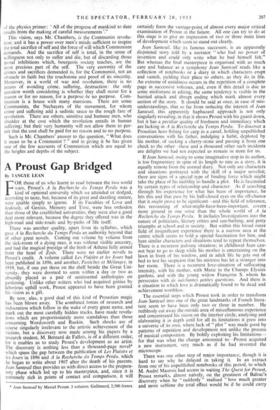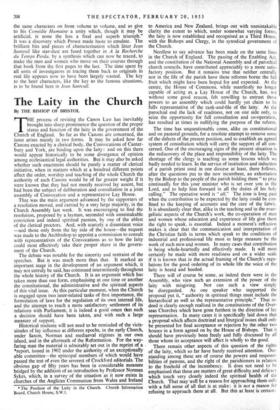A Proust Gap Bridged
By TANGYE LEAN FOR those of us who learnt to read between the two world wars, Proust's A la Recherche du Temps Perdu was a kind of optional university which we attended or dodged, according to taste, but, because of its great and dazzling stature, were unable simply to ignore. If its Faculties of Love and Jealou, of Genius, Memory and Time, were less orthodox than those of the established universities, they were also a good deal more relevant, because the degree they offered was in the high-road and side-roads and by-paths of life itself.
There was another quality, apart from its syllabus, which gave A la Recherche du Temps Perdu an authority beyond that of other great novels. Coming out volume by volume from the sick-room of a dying man, it was without visible ancestry, and had the magical prestige of the birth of Athene fully armed from the head of Zet.N. There were no earlier novels to Proust's credit. A volume called Les Plaisirs et les klirs had been published in 1896, and another, Pastiches et Melanges, in 1919, but, if one put these on the shelf beside the Great Uni- versity, they were doomed to seem within a day or two as absurdly placed as a pair of sentimental anthologies on gardening. Unlike other writers who had acquired genius by laborious uphill work, Proust appeared to have been granted his vision as a gift.
By now, alas, a good deal of this kind of Proustian magic has been blown away. The combined forces of research and indiscretion which follow in the wake of every great name, and mark out the most carefully hidden tracks, have made revela- tions which are proportionately more scandalous than those concerning Wordsworth and Ruskin. Such shocks are of course singularly irrelevant to the artistic achievement of the victims, but a discovery now made among his Papers by a research student, M. Bernard de Fallois, is of a different order. for it enables us to study Proust's development as an artist. The discovery is nothing less than a thousand-page novel* which spans the gap between the publication of Les Plaisirs et les lours in 1896 and A la Recherche du Temps Perdu, which he began to write about 1907 after the death of his parents. Jean Santeuil thus provides us with direct access to the prepara- tory phase which led up to his masterpiece, and, since it is extremely rich in points of contact and comparison, it will • Jean Santeuil by Marcel Proust. 3 volumes. Gallimard, 2,500 francs. certainly form the vantage-point of almost every major critical examination of Proust in the future. All one can try to do at this stage is to give an impression of two or three main lines of development which seem to stand out clearly.
Jean Santeuil, like its famous successor, is an apparently disjointed story told by a narrator "who had no power of invention and could only write what he had himself felt." But whereas the final masterpiece is organised with as much care and balance as a symphony Jean Santeuil reads like a collection of notebooks or a diary in which characters erupt and vanish, yielding their place to others, as they dos in life. An extreme of untidiness occurs in the repetition of a complete page in .successive volumes, and, even if this detail is due to some misfortune in editing, the same tendency is visible in the humed attack and abrupt ending which mark almost every section of the story. It should be said at once, in case of mis- understandings, that so far from reducing the interest of Jean Santeuil, this apparently haphazard approach is not only singularly revealing, in that it shows Proust with his guard down. but it has a peculiar quality of freshness and immediacy which are lacking in A la Recherche du Temps Perdu. To discover a Proustian hero fishing for carp in a canal, holding unpublished conversations with his father, indulging a habit, deplored by his mother, of sucking a cherry-stone and passing it from one cheek to the other—these and a thousand other such incidents are delights we had not expected to remain in store for us.
If Jean Santeuil. owing to some imaginative stop in its author, is too fragmentary in spite of its length to rate as a story, it is equally remote from the normal diary. Not only are characters and situations portrayed with the skill of a major novelist; there are signs of a special type of binding force which might take the place of his inability to handle a plot. He is fascinated by certain types of relationship and character. As if searching through his experience for what has been of importance, ha lets this and that pass by his half-closed eyes on the off-chance that it might prove to be significant—and this field of tolerance, this recounting of what-might-have-been-important, covers more ground in one sense than the whole world of A la Recherche du Temps Perdu. It includes investigations into the nature of politicians, literary critics and sun-bathing, and petty triumphs at school and in society. But within this broad outer field of insignificant experience there is a narrow area at the centre which seems to hold a special fascination for him, and here similar characters and situations tend to repeat themselves. There is a recurrent jealousy situation; in childhood Jean can- not bear to go to sleep while his mother is entertaining on the lawn in front of his window, and in adult life he gets out of bed to test his suspicion that his mistress has let a stranger into her room. There is a recurrent love-situation of suffocating intensity, with his mother, with Marie in the Champs Elysees gardens, and with the young widow Francoise S. whom he persecutes with de mechantes petites questions. And there is a situation in which love is dramatically found to be dead and achievement worthless.
The essential steps which Proust took in order to transform Jean Santeuil into one of the great landmarks of French litera- ture seem to have been only two or three in number. He ruthlessly cut away the outside area of miscellaneous experience and concentrated his vision on the interior circle, analysing and elaborating it in depth until for all its limitations it grew into a universe of its own, where lack of " plot " was made good by patterns of repetition and development not unlike the process of musical composition. By boldly exploiting his limitations— for that was what the change amounted to—Proust acquired a new instrument, very much as if he had invented the microscope.
There was one other step of major importance, though it is hard to see why he delayed in taking it. In an extract from one of his unpublished notebooks of this period, to which M. Andre Maurois had access in waiting The Quest for Proust, Proust remarks, almost naively, on the greatness of Balzac's discovery when he " suddenly " realised "how much greater and more sublime the total effect would be if he could carry the same characters on from volume to volume, and so give to his Comedic' Humaine a unity which, though it may be artificial, is none the less a final and superb triumph." It was a discovery which Proust made haste to emulate. The brilliant bits and pieces of characterisation which litter lean Santeuil like star-dust are fused together in A la Recherche du Temps Perdu, by a synthesis which can now be traced, to make the men and women who move on their courses through that book from the first pages to the last. The time spent by all sorts of investigators in tracing them back to originals in real life appears now to have been largely wasted. The key to the later characters, like the key to the famous situations, is to be found here in Jean Santeuil.



































 Previous page
Previous page